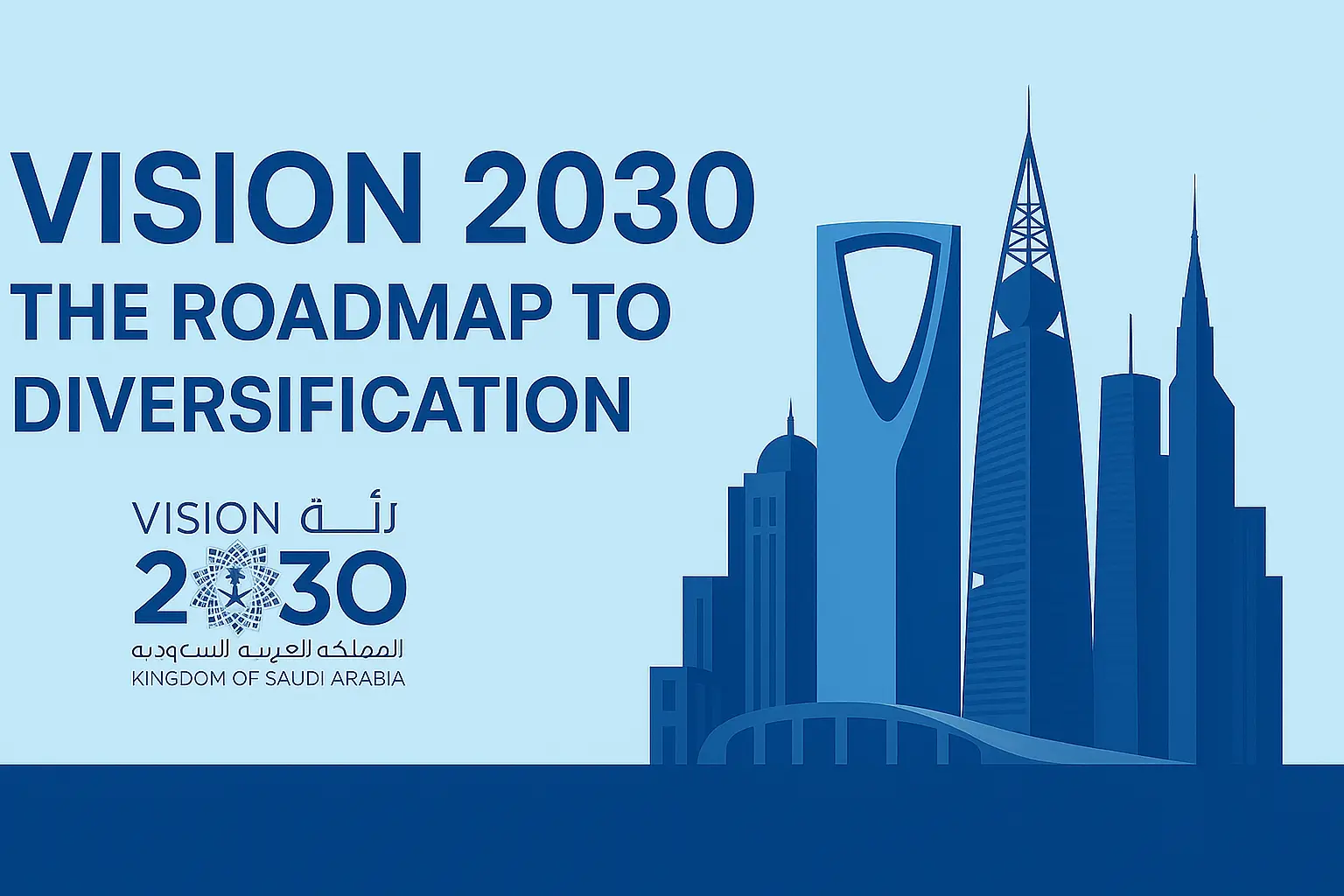Digital Transformation in Saudi Arabia: Key Milestones on the Road to Vision 2030
Introduction: Saudi Arabia’s Bold Leap Toward Digital Transformation
Saudi Arabia’s Vision 2030 is an ambitious roadmap designed to transform the Kingdom’s economy, society, and governance. A central component of this vision is the digital transformation in Saudi Arabia, aimed at reducing the nation’s dependence on oil, fostering economic diversification, and modernizing key sectors through cutting-edge technologies.
This article explores the key milestones that have shaped the digital transformation in Saudi Arabia’s Vision 2030 and how the country is positioning itself as a global leader in digital technologies. Through the integration of AI, cloud computing, smart cities, and digital governance, Saudi Arabia is building a sustainable future that aligns with its strategic goals.
1. Launch of Vision 2030: A Strategic Focus on Digital Transformation
When Vision 2030 was launched by Crown Prince Mohammed bin Salman in April 2016, digital transformation emerged as one of the core pillars of the national strategy. Saudi Arabia recognized the importance of embracing new technologies as the foundation for future growth and development. The government set out to digitize its infrastructure, public services, and business sectors to create a competitive and diversified economy.
The plan outlined several digital transformation milestones, such as the establishment of key digital infrastructures and the creation of technology hubs to foster innovation and global investment. Vision 2030’s focus on digital transformation in Saudi Arabia encompasses everything from AI to IoT and cloud computing, providing a roadmap to modernize governance, commerce, and daily life.
2. Establishment of the Saudi Data and Artificial Intelligence Authority (SDAIA)
A significant milestone in the digital transformation in Saudi Arabia Vision 2030 was the creation of the Saudi Data and Artificial Intelligence Authority (SDAIA) in 2019. SDAIA is responsible for overseeing the implementation of AI technologies and ensuring the ethical use of data across various sectors, including healthcare, education, and government services.
SDAIA’s efforts align with Vision 2030 by promoting AI-driven innovation and helping the Kingdom become a regional leader in digital technologies. The authority’s work includes advancing artificial intelligence, fostering data-driven governance, and establishing a regulatory framework to manage AI, making it a critical part of Saudi Arabia’s digital transformation.
3. Digital Government Strategy: E-Government Development
The digital government strategy plays a pivotal role in Vision 2030 by enabling the Kingdom to offer more efficient and accessible public services. Under this initiative, Saudi Arabia has taken significant steps to digitize its government services, making them available to citizens online through e-portals, mobile apps, and other digital channels.
With over 97% of government services now digitized, the digital transformation in Saudi Arabia has significantly streamlined processes such as healthcare registration, social welfare distribution, and tax collection. The Digital Government Authority continues to enhance e-government services, enabling more responsive governance and improved citizen engagement.
4. Smart Cities and Digital Infrastructure Development
Saudi Arabia is also leading the charge in smart city development as part of its Vision 2030. NEOM, one of the largest and most ambitious projects under Vision 2030, is a futuristic city designed with smart infrastructure at its core. NEOM is a living example of how digital transformation in Saudi Arabia is shaping urban environments. The city will feature AI-driven transportation systems, sustainable energy grids, and IoT-enabled services, all contributing to the Kingdom’s goal of building tech-powered, sustainable urban centers.
Beyond NEOM, Saudi Arabia’s commitment to smart cities extends to other projects like The Line and Oxagon, where AI and digital infrastructure are key drivers of urban development. These smart cities will rely on cutting-edge technologies like autonomous vehicles, cloud computing, and real-time data analytics to optimize resources and provide a higher quality of life for their residents.
5. The Role of AI in Saudi Arabia’s Digital Future
Artificial Intelligence (AI) is a cornerstone of the digital transformation in Saudi Arabia’s Vision 2030. The Kingdom has made it a priority to lead the Arab world in AI adoption, and this commitment is reflected in the significant investments being made in AI research, development, and applications.
Saudi Arabia is positioning itself to capitalize on AI’s potential to drive economic growth, improve public services, and create a competitive workforce. The Saudi Artificial Intelligence Strategy sets ambitious goals, including increasing AI’s contribution to GDP and making AI a central element in sectors such as healthcare, transportation, and logistics.
In addition, AI technologies are being integrated into public administration to improve decision-making, streamline government services, and enhance the overall citizen experience.
6. Cloud Computing and Data Centers: Enabling Digital Growth
Cloud computing has become an essential enabler of Saudi Arabia’s digital transformation. In 2023, the Kingdom opened the first cloud computing special zone in the region, aimed at attracting both local and international cloud service providers. The establishment of this zone supports Vision 2030’s objective to foster digital growth and innovation across industries.
With cloud computing, businesses can scale operations efficiently while adhering to local data privacy regulations. Additionally, cloud services are transforming sectors like healthcare by enabling the storage of vast amounts of medical data, improving patient care through digital health solutions, and offering new opportunities for research and innovation.
7. Digital Transformation in Education and Workforce Development
Education is another area where digital transformation in Saudi Arabia is making significant strides. Under Vision 2030, Saudi Arabia has introduced several initiatives to enhance digital literacy and prepare its workforce for the challenges of the 21st-century economy. Programs like the Human Capability Program are designed to ensure that every citizen has access to lifelong learning opportunities.
AI-driven educational platforms, e-learning tools, and digital classrooms are becoming commonplace, helping students and professionals develop the skills needed in a tech-driven economy. By 2030, the Kingdom aims to equip its population with the skills required for a digital future, particularly in areas like AI, data science, and cloud computing.
8. The Digital Economy: Fostering Innovation and Entrepreneurship
Saudi Arabia’s Vision 2030 recognizes the importance of fostering a digital economy to fuel innovation and entrepreneurship. With initiatives such as the National Transformation Program, the Kingdom is creating an ecosystem where technology startups, SMEs, and global investors can thrive.
Digital infrastructure is being enhanced to support entrepreneurship, and the government is providing financial and regulatory support to businesses involved in the tech industry. By encouraging innovation in fintech, e-commerce, and digital services, Saudi Arabia is creating new business models and generating new employment opportunities.
9. Cybersecurity and Data Governance: Safeguarding Digital Assets
As Saudi Arabia embarks on its digital transformation, ensuring robust cybersecurity and data governance is critical. With more data being generated and stored digitally, the need to protect sensitive information has never been more pressing.
The Kingdom has introduced policies to safeguard data privacy and maintain security standards across sectors. The establishment of cybersecurity frameworks and the Digital Government Strategy ensures that digital systems are protected against cyber threats, providing businesses and citizens with confidence in the safety of their data.
Conclusion: The Path to a Digital Future
The digital transformation in Saudi Arabia’s Vision 2030 is rapidly taking shape, marking a monumental shift in the Kingdom’s approach to governance, business, and social development. Through strategic investments in AI, cloud computing, smart cities, and digital governance, Saudi Arabia is positioning itself as a regional leader in innovation, technology, and sustainability.
As the Kingdom continues to embrace technology, it will unlock new economic opportunities, enhance public services, and improve the quality of life for its citizens. The road to Vision 2030 is clear, and Saudi Arabia’s commitment to digital transformation will be crucial in ensuring its future success as a global economic powerhouse.
Read article
AI for a Sustainable Future: Saudi Arabia’s Green Vision
FAQs about Digital Transformation in Saudi Arabia and Vision 2030
Q1: What is digital transformation in Saudi Arabia’s Vision 2030?
A1: Digital transformation in Saudi Arabia Vision 2030 refers to the integration of advanced technologies like artificial intelligence (AI), cloud computing, and IoT into government operations, business sectors, and public services. This transformation aims to diversify the economy, improve efficiency, and create a sustainable future for the Kingdom.
Q2: How does Vision 2030 focus on digital transformation?
A2: Vision 2030 places a strong emphasis on digital transformation as a means of economic diversification and modernization. By digitizing public services, promoting AI and cloud computing, and developing smart cities, Saudi Arabia is positioning itself to become a leader in digital innovation, reducing its reliance on oil revenues.
Q3: What are the key milestones of digital transformation in Saudi Arabia?
A3: Key milestones include the establishment of the Saudi Data and Artificial Intelligence Authority (SDAIA), the Digital Government Strategy, the creation of smart cities like NEOM, the adoption of AI technologies in various sectors, and the launch of cloud computing zones to encourage digital business growth.
Q4: How is AI contributing to digital transformation in Saudi Arabia?
A4: AI is playing a vital role by enhancing public services, improving decision-making, optimizing resource management, and enabling smart city operations. AI technologies are being used in sectors like healthcare, transportation, education, and government services to increase efficiency and create personalized experiences.
Q5: What role does cloud computing play in Saudi Arabia’s digital transformation?
A5: Cloud computing is essential for providing scalable infrastructure to support digital services. It allows businesses and government agencies to store and process data efficiently while complying with local data regulations. Saudi Arabia has established cloud zones to attract international cloud providers and foster local tech ecosystems.
Q6: How are smart cities like NEOM contributing to the digital transformation of Saudi Arabia?
A6: NEOM is a pioneering project that integrates AI, IoT, and digital infrastructure into urban planning. This smart city will feature autonomous vehicles, AI-driven services, and sustainable infrastructure, providing a model for other cities in Saudi Arabia and the region.
Q7: What is the role of digital governance in Vision 2030?
A7: Digital governance is a critical component of Vision 2030, aiming to streamline public services, increase transparency, and improve government efficiency. The Digital Government Strategy is focused on digitizing government operations, offering e-services, and implementing secure digital frameworks to better serve citizens and businesses.
Q8: How is Saudi Arabia using data analytics in its digital transformation efforts?
A8: Data analytics is being utilized to enhance decision-making, improve public policy, and optimize resource allocation. The government uses big data and AI to predict trends, monitor services, and ensure that public services are tailored to meet the evolving needs of residents.
Q9: How will digital transformation affect the workforce in Saudi Arabia?
A9: Digital transformation will drive the creation of new job opportunities, particularly in the tech sector. It will also require upskilling the workforce, with a focus on AI, cloud computing, and data science. Programs like the Human Capability Program are designed to equip citizens with the necessary digital skills to thrive in the future job market.
Q10: What are the future digital transformation goals for Saudi Arabia under Vision 2030?
A10: By 2030, Saudi Arabia aims to become a global leader in digital innovation, with a fully digitized government, widespread adoption of AI across sectors, smart city developments, and an advanced tech-driven economy. The Kingdom also plans to improve its digital governance rank and ensure its digital economy is robust, inclusive, and sustainable.


